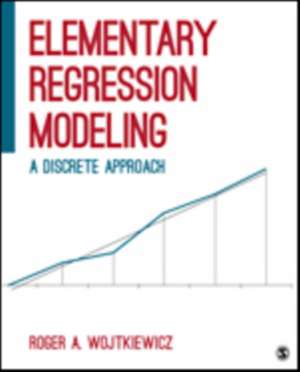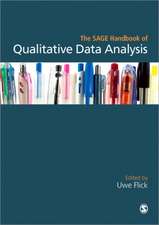Elementary Regression Modeling: A Discrete Approach
Autor Roger A. Wojtkiewiczen Limba Engleză Paperback – 12 iul 2016
Preț: 608.64 lei
Preț vechi: 716.05 lei
-15% Nou
116.46€ • 121.90$ • 96.93£
Carte tipărită la comandă
Livrare economică 31 martie-14 aprilie
Specificații
ISBN-10: 1506303471
Pagini: 240
Dimensiuni: 187 x 232 x 8 mm
Greutate: 0.32 kg
Ediția:1
Editura: SAGE Publications
Colecția Sage Publications, Inc
Locul publicării:Thousand Oaks, United States
Cuprins
Regression Modeling
Control Modeling
Modeling Interactions
Modeling Linearity With Splines
Testing Research Hypotheses
Classical Approach to Regression
Disadvantages of Classical Approach
Discrete Approach to Regression
Summary
Key Concepts
Notes
Chapter 2: Basic Statistical Procedures
Individual Units and Groups
Measurement
Level of Measurement
Examples for Level of Measurement
Count, Sum, and Transformations
Mean
Proportion and Percentage
Odds and Log odds
Examples of Means and Log Odds
Differences
Summary
Key Concepts
Chapter Exercises
Notes
Chapter 3: Regression Modeling Basics
Difference between Means: The t-test
Linear Regression With a Two-Category Independent Variable
Logistic Regression With a Two-Category Independent Variable
Linear Regression With a Four-Category Independent Variable
Logistic Regression With a Four-Category Independent Variable
Modeling Linear Effect With Dummy Variables
Linear Coefficient in Linear Regression
Linear Coefficient in Logistic Regression
Using Dummy Variables for a Continuous Variable
Summary
Key Concepts
Chapter Exercises
Notes
Chapter 4: Key Regression Modeling Concepts
Unit Vector: Estimating the Intercept
Nestedness
Higher-Order Differences
Constraints
Summary
Key Concepts
Chapter Exercises
Notes
Chapter 5: Control Modeling
Elementary Control Modeling
Elaboration for Controlling
Demographic Standardization for Controlling
Small and Big Models
Allocating Influence With Multiple Control Variables
One-at-a-Time Without Controls
Step Approach
One-at-a-Time With Controls
Hybrid Approach
Nestedness and Constraints
Example Using Logistic Regression
Summary
Key Concepts
Chapter Exercises
Notes
Chapter 6: Modeling Interactions
Interactions as Conditional Differences
Interactions Between Dummy Variables
Interactions Between Dummy Variables and an Interval Variable
Three-Way Interactions
Estimating Separate Models
Example Using Logistic Regression
Summary
Key Concepts
Chapter Exercises
Notes
Chapter 7: Modeling Linearity With Splines
Dummy Variables Nested in an Interval Variable
Introduction to Knotted Spline Variables
Spline Variables Nested in an Interval Variable
Regression Modeling Using Spline Variables
Working With a Continuous Independent Variable
Example Using Logistic Regression
Summary
Key Concepts
Chapter Exercises
Notes
Chapter 8: Conclusion: Testing Research Hypotheses
Bivariate Hypothesis/No Controls
Bivariate Hypothesis/Unanalyzed Controls
Bivariate Hypothesis/Analyzed Controls
Hypothesis Involving Interactions
Hypothesis Involving Nonlinearity
Final Comments
Key Concepts
Summary
Chapter exercises
Notes
Notă biografică
Roger A. Wojtkiewicz is Professor in the Department of Sociology at Ball State University in Muncie Indiana. He spent the first twelve years of his career in the Department of Sociology at Louisiana State University and has since been at Ball State where he served as department chairperson for twelve years. At LSU, he taught undergraduate statistics and a graduate course in regression modeling in the PhD program. It was at LSU where he began the development of the ideas contained in the book. At Ball State, he has taught both the first and second semester courses in the statistics sequence in the master¿s program and it is at Ball State where he finalized the ideas contained in the book. He also uses some of the basic ideas about regression analysis found in the book in the undergraduate statistics course that he teaches each semester. He was trained as a quantitative methodologist in the graduate sociology program at the University of Wisconsin-Madison. His research approach is quantitative and he uses regression analysis to examine issues in the areas of family demography and educational stratification.





